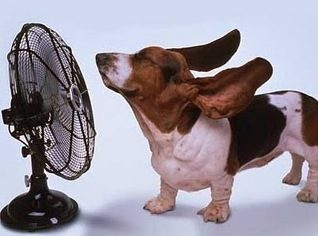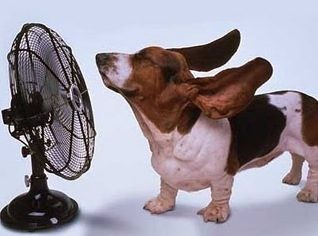

Baked
Here in Seattle, we’ve pretty much escaped the heat wave that the rest of the country has been suffering through. So, when I took big, fifteen year-old Flavio with me to a radio station interview last week, I made sure that he would be in the car for as little time as possible, even though the temperature was only a pleasant 72 or so.
On the way home, I stopped for two minutes to drop off a DVD rental. Flavio lay in the back, panting a bit- something he does now due to the slow deterioration of his cardio-respiratory system. But he was well-watered, and the windows were open; he’d be fine for the 120 seconds I’d be gone.
Back at my car, I found a woman standing there with a Chihuahua on a leash, her cell phone to her ear. When I approached, she put the phone away and sheepishly explained that she felt Flavio was in duress from the heat. I thanked her for her concern, and explained the dog’s condition, and that I’d just run across the street and back. In the meantime, Flavio stared out the window at the Chihuahua, wondering what kind of new squeeze toy I’d brought him.
She’d done a good thing, and I was appreciative. It’s not easy to make that call, especially when you see the owner coming back to the car. Some owners take it personally and go postal, despite the fact that they’re often flat out wrong, and unrepentant about it. Knuckleheads.
Today, most of the continent is baked, toasted, roasted. Most towns and cities have seen temperatures above 90 degrees for months. Even our Canadian friends to the north have been fricasseed this summer. It’s dangerous, for both young and old. And it kills dogs.
When heat waves hit for extended periods of time, often the first to suffer are our dogs. Owners used to keeping their pets outside in a yard or pen, for instance, often fail to consider what triple-digit temperatures can do to a dog, especially one that’s old, or small. Often there’s little water, due to the small bowl losing its contents to evaporation. Shade, too, is often unavailable, making heat stroke more likely. A smart dog will either find some scant shade, or else dig down into cool soil, if possible, but sometimes conditions just won’t allow this. Try digging down into Phoenix dirt in August.
Even dogs kept indoors can suffer, if there is no reasonable way to cool the home down, and the temperature gets up above eighty degrees. Small breeds, puppies, dogs with short muzzles, heavily-coated breeds, or older dogs can all succumb, especially if they are in a crate with no water.
A parked automobile in the hot summer is basically a convection oven waiting to cook your dog. Even with windows cracked, most cars will become infernos after just twenty minutes. It makes sense then, to leave your dog home if you know you’ll be making a stop for any length of time. I know of small dogs that have literally died of overheating in cars, so trust me on this. Even leaving water won’t help in the car. And, you run the risk of having someone calling the police on you.
Warning signs? Excess panting, difficulty breathing, and even vomiting, diarrhea, and seizures are all possible. If you know your dog, you’ll know if he or she is overheated.
Apart from heat exhaustion, some dogs can even get sunburned. The Mexican Hairless, for example, needs to have a vet-approved non-toxic sunscreen applied to its bare skin, if out in the sun often. Even normal dogs can get a burned nose, so be aware of it.
Exercise during extreme heat should be minimized, to prevent dehydration. And beware of hot surfaces; asphalt and concrete can literally get hot enough to cook an egg during the summer. If you can’t keep your hand on a sidewalk surface for more than fifteen seconds, your dog will end up burning his or her pads on even a short walk.
Merchants will often place bowls of water out for thirsty dogs, during heat waves. Though a goodhearted gesture, it’s not a good idea to let your dog drink from one, unless absolutely necessary. Do the math; if a hundred dogs drink out of one bowl, the odds of one of them carrying some contagious condition is pretty high. If out on a long walk or hike with my dogs in high heat, I always take water for them.
If at all possible, get your dog indoors on a hot day, in a reasonably cool home. If he or she must be outdoors, leave a bucket of fresh water with ice cubes in it. Be sure to set up a shady area for your dog to rest. If need be, hose him or her down before you leave.
Also be aware that, during high heat, thunderstorms can occur. If your dog gets phobic over thunder (what dog doesn’t?), keeping him or her inside is a kinder option.
Take a lot of water with you on hikes, and keep jogging to a minimum. Avoid letting your dog become obese, as this will compound the chance of heat exhaustion. Take your dog swimming, but be sure to supervise, and not overdo it.
The jury is out on whether or not to trim your dog’s coat during extremely hot weather. I used to trim Flavio’s Shepherd/Chow coat, but do not anymore, as I think it actually can help insulate him from heat as well as cold. But if you think your Samoyed, Chow, or Old English Sheepdog can benefit from a trim, give it a go. Just don’t shave them completely.
Some breeds do better in heat than others. Sighthounds generally do okay, with the possible exception of an Afghan in full coat. But Basenjis, Greyhounds, Ibizans, Salukis, and other desert-originating breeds can tolerate heat better than can a Siberian Husky, Chow, Malamute, or even a Golden Retriever.
When temperatures get to hot for you to be comfortable, it’s too hot for your dog, too. Though they’re resilient and often stoic about discomfort, trust me- triple-digit heat is murder on dogs. Keep them cool, watered, rested and close.
Join the newsletter and never miss out on dog content again!
"*" indicates required fields
By clicking the arrow, you agree to our web Terms of Use and Privacy & Cookie Policy. Easy unsubscribe links are provided in every email.